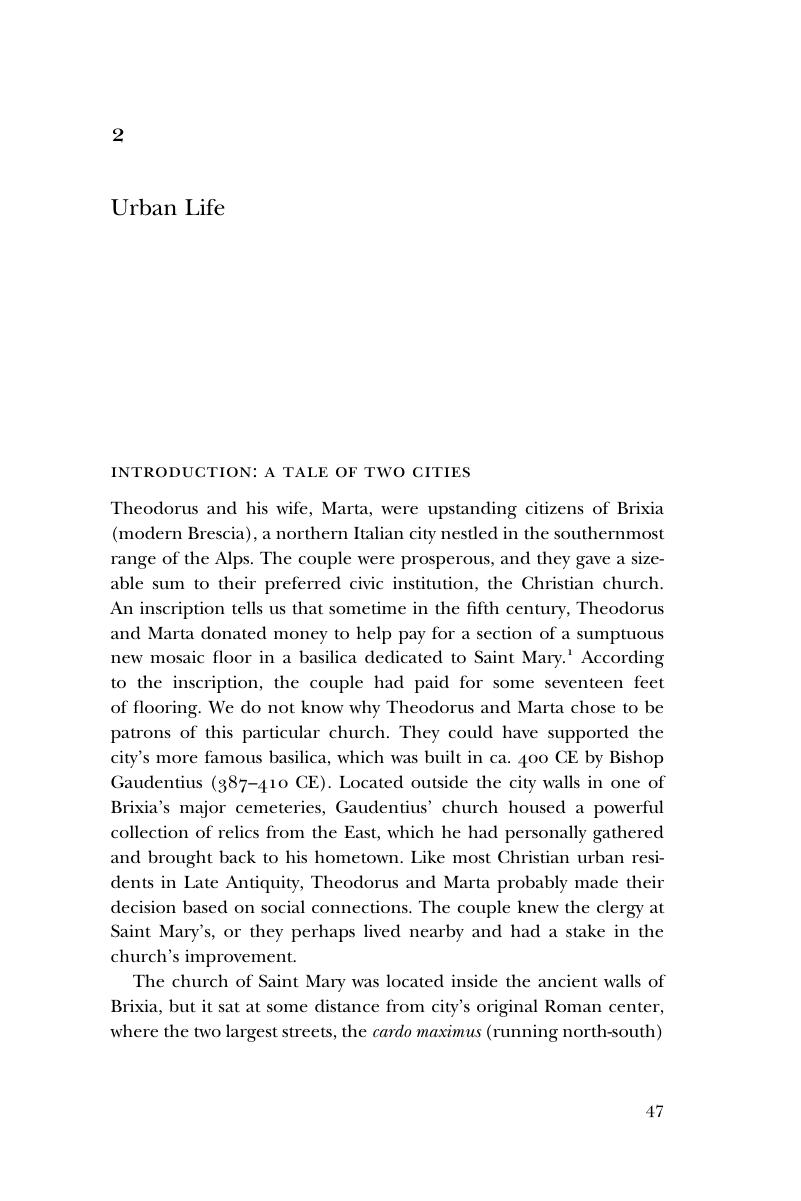Published online by Cambridge University Press: 18 June 2018

Readers interested in general studies of urban change in Late Antiquity can consult J. Rich (ed.), The City in Late Antiquity (London, 1992) and the introduction and first chapter of H. Dey, The Afterlife of the Roman City: Architecture and Ceremony in Late Antiquity and the Early Middle Ages (Cambridge, 2015). An especially detail-oriented reader will appreciate the comprehensive study by I. Jacobs, Aesthetic Maintenance of Civic Space. The ‘Classical’ City from the 4th to the 7th c. AD (Orientalia Lovaniensia Analecta 193) (Leuven, 2013). Anyone interested in the changing symbolic meaning of cities will enjoy C. Rapp and H. Drake (eds.), The City in the Classical and Post-Classical World. Changing Contexts of Power and Identity (Cambridge, 2014).
Scholars of Late Antiquity typically focus on individual regions or cities, or even specific urban buildings or spaces. For Constantinople, see S. Bassett, The Urban Image of Late Antique Constantinople (Cambridge, 2004). For Rome and Italy, see R. Krautheimer, Rome: Profile of a City, 312–1308 (Princeton, NJ, 1980), along with B. Ward Perkins, From Classical Antiquity to the Middle Ages: Urban Public Buildings in Northern and Central Italy, AD 300–850 (Oxford, 1984). For Sardis and Ephesus, see C. Foss, Byzantine and Turkish Sardis (Cambridge, 1976) and Ephesus After Antiquity (Cambridge, 1979). For Alexandria, see C. Haas, Alexandria in Late Antiquity: Topography and Social Change (Baltimore, 1997). For North Africa, see A. Leone, Changing Townscapes in North Africa from Late Antiquity to the Arab Conquest (Bari, 2007). Unfortunately, there are no English-language publications on late Roman Brixia, but readers who know a little Italian can consult the museum catalogue entitled Brixia, scoperte e riscoperte. Museo Santa Giulia (Brescia, 2003). On baths and bathing, see F. Yegül, Bathing in the Roman World (Cambridge, 2010). On early Christian churches, see R. Krautheimer, Early Christian and Byzantine Architecture (London, 1981) for a broad introduction.
A good general introduction to urban labor and economics is P. Garnsey and C. Whittaker, “Trade, Industry, and the Urban Economy,” in The Cambridge Ancient History, vol. 13 (Cambridge, 2000), 312–337. For prostitution, see T. McGinn, The Economy of Prostitution in the Roman World. A Study of Social History and the Brothel (Ann Arbor, MI, 2004) and K. Harper, From Shame to Sin: The Christian Transformation of Sexual Morality in Late Antiquity (Cambridge, MA, 2013). Readers interested in urban entertainment may consult S. Remijsen, The End of Greek Athletics in Late Antiquity (Cambridge, 2015), C. Rouché, Performers and Partisans at Aphrodisias in the Roman and Late Roman Periods (London, 1993), and A. Cameron, Circus Factions (Oxford, 1975). For the theater, see R. Webb, Demons and Dancers: Performance in Late Antiquity (Cambridge, MA, 2008).
To save this book to your Kindle, first ensure no-reply@cambridge.org is added to your Approved Personal Document E-mail List under your Personal Document Settings on the Manage Your Content and Devices page of your Amazon account. Then enter the ‘name’ part of your Kindle email address below. Find out more about saving to your Kindle.
Note you can select to save to either the @free.kindle.com or @kindle.com variations. ‘@free.kindle.com’ emails are free but can only be saved to your device when it is connected to wi-fi. ‘@kindle.com’ emails can be delivered even when you are not connected to wi-fi, but note that service fees apply.
Find out more about the Kindle Personal Document Service.
To save content items to your account, please confirm that you agree to abide by our usage policies. If this is the first time you use this feature, you will be asked to authorise Cambridge Core to connect with your account. Find out more about saving content to Dropbox.
To save content items to your account, please confirm that you agree to abide by our usage policies. If this is the first time you use this feature, you will be asked to authorise Cambridge Core to connect with your account. Find out more about saving content to Google Drive.